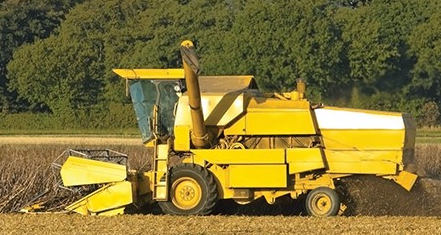Reducing Diesel Emissions from Construction and Agriculture
Construction

Diesel equipment provides the power needed for almost all construction activities. However, emissions from construction equipment impact the health of people working on and living near construction sites.
While EPA regulations apply to new engines, older diesel engines can remain in operation for 30 years or more. Reducing exposure to diesel exhaust in and around construction areas is important for human health and the environment.
EPA offers funding, as appropriated annually by Congress, for projects that reduce emissions from existing diesel engines. EPA’s Clean Construction also provides information on strategies for reducing emissions from older engines, including idle-reduction practices that save money and fuel while reducing emissions.
Construction fleet owners are finding that operating cleaner diesel fleets makes them more competitive for Green Building jobs. As Green Building standards and codes are becoming more common, construction fleets are becoming cleaner.
Project owners also play important roles in reducing diesel emissions at construction sites and in nearby buildings that take in emissions through air intakes, doors and windows. To help protect the health of on-site personnel and maintain good community relations, project owners should establish a Diesel Emission Reduction policy for their projects.
Key Elements of a Successful Diesel Emission Reduction Policy
- Include Diesel Emission Reduction specifications or performance standards in contracts.
- Use Model Contract Specification to provide Diesel Emission Reduction language in construction contracts.
- Emphasize the Diesel Emission Reduction policy during the bid process and throughout project.
- Hold construction managers accountable for successfully implementing the Diesel Emission Reduction policy by making sure they:
- thoroughly understand all elements of the policy
- fully educate all contractors on Diesel Emission Reduction requirements throughout the duration of the project
- implement a tracking system
- see that all contract requirements are met
-
Respond to and resolve all issues regarding the policy.
Resources
Printed publications on reducing emissions from school buses can be ordered from the National Service Center for Environmental Publications.
- Best Practices for Clean Diesel Construction: Successful Implementation of Equipment Specifications to Minimize Diesel Pollution (pdf) (848 KB, August 2010, EPA-420-F-10-018)
- Cleaner Diesels: Low Cost Ways to Reduce Emissions from Construction Equipment (pdf) (423 KB, March 2007, EPA-R-07-002)
- Construction Fleet Inventory Guide (pdf) (10.6 MB, July 2010, EPA-420-B-10-025)
- Model Contract Specification
- Clean Construction USA - The Green Building Sector is Growing Rapidly. Grow With It (pdf) (10.6 MB, August 2010, EPA-420-F-10-018)
- EPA's ENERGY STAR
- Clean Construction Pilot Credit that can be used toward Leadership in Energy and Environmental Design (LEED) certification
- Diesel Technology Forum: Construction
- California’s Construction and Demolition Debris Recycling
- California-Carl Moyer Program
Agriculture

EPA’s Clean Agriculture helps farmers, ranchers, and agribusinesses reduce emissions from older diesel engines currently in use. Because these engines can last 30 years or more and are not subject to EPA’s emissions standards for new diesel engines, they will continue to emit harmful pollutants. Reducing exposure to diesel exhaust is important for human health and the environment.
EPA offers funding, as appropriated annually by Congress, for projects that reduce emissions from existing diesel engines. EPA’s Clean Agriculture also provides information on strategies for reducing emissions from older engines, including idle-reduction practices that save money and fuel while reducing emissions.
Resources
Printed publications on reducing emissions from school buses can be ordered from the National Service Center for Environmental Publications.
- Clean Agriculture USA - Cleaner Air Over Greener Fields (pdf) (789 KB, August 2010, EPA-420-F-10-017)
- Diesel Technology Forum: Agriculture
- USDA Partnerships with Farmers and Ranchers to Address Climate Change
- USDA’s Building Blocks for Climate Smart Agriculture & Forestry (pdf) (11.3 MB, May 2016)
- USDA’s Natural Resources Conservation Service (NRCS)
